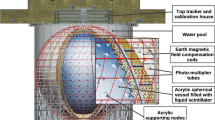Abstract
KM2A is one of the main sub-arrays of LHAASO, working on gamma ray astronomy and cosmic ray physics at energies above 10 TeV. Detector simulation is the important foundation for estimating detector performance and data analysis. It is a big challenge to simulate the KM2A detector in the framework of Geant4 due to the need to track numerous photons from a large number of detector units (>6000) with large altitude difference (30 \(\mathrm m\)) and huge coverage (1.3 \(\mathrm km^{2}\)). In this paper, the design of the KM2A simulation code G4KM2A based on Geant4 is introduced. The process of G4KM2A is optimized mainly in memory consumption to avoid memory overflow. Some simplifications are used to significantly speed up the execution of G4KM2A. The running time is reduced by at least 30 times compared to full detector simulation. The particle distributions and the core/angle resolution comparison between simulation and experimental data of the full KM2A array are also presented, which show good agreement.












Similar content being viewed by others
References
Z. Cao, A future project at tibet: the large high altitude air shower observatory (LHAASO). Chin. Phys. C 34, 249 (2010)
H.H. He, LHAASO Collaboration, Design of the LHAASO detectors. Radiat. Detect. Technol. Methods 2, 7 (2018)
Y. Liu, Z. Cao, S.Z. Chen et al., Expectation on observation of supernova remnants with the LHAASO project. ApJ 826, 63 (2016)
C. Jin et al., Classifying cosmic-ray proton and light groups in LHAASO-KM2A experiment with graph neural network. Chin. Phys. C 44, 065002 (2020)
D. Heck et al., CORSIKA: a Monte Carlo code to simulate extensive air showers, Forschungszentrum Karlsruhe Report No. FZKA 6019 (1998)
S. Agostinelli, J. Allison, K. Amako et al., GEANT4-a simulation toolkit. Nuclear Inst. and Methods in Physics Research, A 506, 250 (2003)
F. Aharonian et al., LHAASO collaboration, Observation of the Crab Nebula with LHAASO-KM2A - a performance study. Chin. Phys. C 45, 025002 (2021)
Z. Cao et al., Ultrahigh-energy photons up to 1.4 petaelectronvolts from 12 \(\gamma \)-ray Galactic sources. Nature 594, 33 (2021)
Z. Cao et al., Peta-electron volt gamma-ray emission from the Crab Nebula. Science 373, 425 (2021)
J. Allison et al., GEANT4 collaboration, Geant4 developments and applications. IEEE Trans. Nucl. Sci. 53, 270 (2006)
Y. Yu et al., Study of the performance of photomultiplier tubes at high variable counting rate. Nuclear Inst. Methods Phys. Res., A 1008, 165433 (2021)
Y. Li et al., High dynamic range base design and characterization of an 8-inch photomultiplier tube CR365-02-2 for the LHAASO-MD experiment. Nuclear Inst. Methods Phys. Res., A 1025, 166190 (2022)
S. Wu, L. Chen, S.Z. Chen et al., Study of the trigger mode of LHAASO-KM2A. Astropart. Phys. 103, 41 (2018)
T.K. Gaisser, Cosmic ray energy spectrum from measurements of air showers. Front. Phys. 8, 748 (2013)
R. Jörg, Hörandel, On the knee in the energy spectrum of cosmic rays. Astropart. Phys. 19, 193 (2003)
M. Merck, A. Karle et al., Methods to determine the angular resolution of the HEGRA extended air shower scintillator array. Astropart. Phys. 5, 379 (1996)
Y. Nan et al., The performances of the LHAASO-KM2A tested by the observation of cosmic-ray Moon shadow. Proc. Sci. ICRC2021, 350 (2021)
Acknowledgements
We would like to thank all staff members who work at the LHAASO site above 4400 meters above sea level year-round to maintain the detector and keep the water recycling system, electricity power supply and other components of the experiment operating smoothly. We are grateful to Chengdu Management Committee of Tianfu New Area for the constant financial support for research with LHAASO data. We deeply appreciate the computing and data service support provided by the National High Energy Physics Data Center for the data analysis in this paper. This research work is also supported by the following grants: The National Key R &D program of China under grants 2018YFA0404201, by the National Natural Science Foundation of China (NSFC) No. 12022502, No. 12205314, No. 12105301, No. 12261160362, No. 12105294, No. U1931201, No. 12393851, No. 12393854. In Thailand, support was provided by the National Science and Technology Development Agency (NSTDA) and the National Research Council of Thailand (NRCT) under the High-Potential Research Team Grant Program (N42A650868).
Author information
Authors and Affiliations
Consortia
Corresponding authors
Ethics declarations
Conflict of interest
The authors declare that they have no conflict of interest.
Rights and permissions
Springer Nature or its licensor (e.g. a society or other partner) holds exclusive rights to this article under a publishing agreement with the author(s) or other rightsholder(s); author self-archiving of the accepted manuscript version of this article is solely governed by the terms of such publishing agreement and applicable law.
About this article
Cite this article
Cao, Z., Aharonian, F., An, Q. et al. LHAASO-KM2A detector simulation using Geant4. Radiat Detect Technol Methods (2024). https://doi.org/10.1007/s41605-024-00467-8
Received:
Accepted:
Published:
DOI: https://doi.org/10.1007/s41605-024-00467-8




